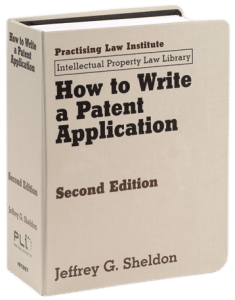
While this book won’t train someone by itself, it is an invaluable tool for learning the ins and outs of patent drafting. Sheldon himself notes:
This book should not be used alone to learn how to write a patent application. No one can expect to read this book and be able to sit down and write a satisfactory patent application. The guidance, assistance, and tutelage of a skilled practitioner will be needed.
The goal of patent application drafting is always to end up with a patent that is both held valid by the courts and infringed by competitors. If missing one of these two items, the patent is worthless. The Sheldon book helps anyone with this goal in mind.
I find that every time I leaf through the book, I am reminded of one concept of another that I need to consider when drafting an application. For example, in a section on Functional Language, Sheldon writes:
Functional statements should be placed either at the end of the description of the particular element after everything necessary to support the functional clause has been set out, or at the end of the claim when all the elements of the claim are necessary to support the functional expression. In general, a claim is easier to follow when the function of an element is recited immediately after the element itself. Also, a claim is less likely to be considered overly broad when the functions are set out one at a time rather than at the end of the claim.
“Whereby” Clauses
“Whereby” and “thereby” clauses are proper only when they describe a function or result that necessarily follows from a previously recited structure. Unlike a means clause, the “whereby” clause has been judicially construed not to define any structure. Thus, a “whereby” clause in a means-pIus-function clause merely states the result of the limitations in the means clause, and adds nothing of substance to the claim.
Accordingly, a “whereby” clause must be preceded by some recitation of structure. Such clauses should only be used when the equivalent phrase “it follows from the foregoing that” can be used to replace he “whereby” clause.
How to Write a Patent Application is an invaluable resource for reviewing topics and re-thinking procedures that may be followed more out of old habit than thoughtful reflection. As pointed out by the author, if your invention is worth filing a patent application, it is worth hiring a skilled practitioner to make certain that the application adequately claims the invention and meets the statutory requirements for a patent application. A poorly written and inadequate patent application will provide a false sense of security and in the long run probably cost much more money. Or even everything.
The book covers diverse topics beyond just preparing the specification and claims including design and plant patent applications as well as preparing foreign patent applications based on a U.S. application. Of course, the book could certainly cover yet further topics. I know some people have said that the book should include information on strategies for responding to Office Actions, like §103 obviousness rejections, the book really is just for drafting the application. I highly recommend this book to any practitioner at any level.
While not a book to read in one sitting, it has a place on everyone’s shelf.
You can get your own copy here: “How to Write a Patent Application” (Jeffrey G. Sheldon, Second Edition), Practicing Law Institute; April 24, 2010; 1268 pages [2].
About the Author
Author Jeffrey Sheldon is the founding partner of Sheldon Mak & Anderson PC, an intellectual property law firm with offices in Pasadena, California. Mr. Sheldon is a summa cum laude graduate of Loyola Law School. He has a Bachelor of Science degree in Chemical Engineering from the Carnegie Institute of Technology, and a Master of Science degree in Biomedical Engineering from the University of Strathclyde, Glasgow, Scotland. He has been adjunct professor in intellectual property law and patent law at Southwestern University Law School and advanced patent law at Loyola University, both in Los Angeles. He is a frequent lecturer for Practising Law Institute and other organizations.